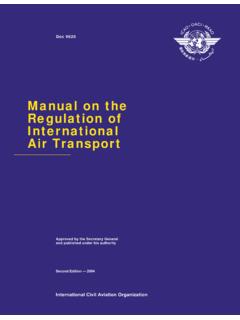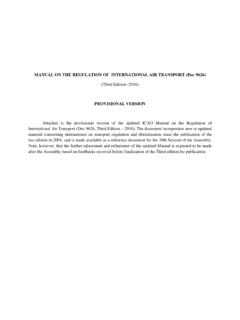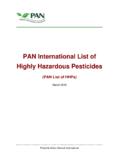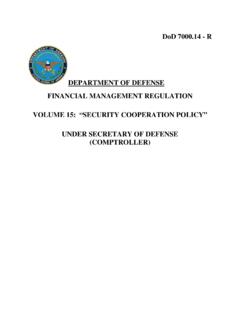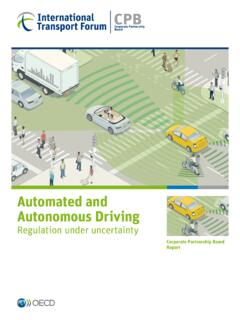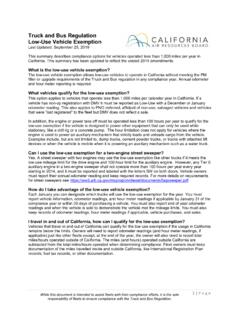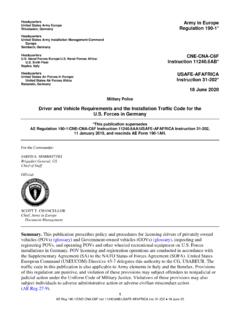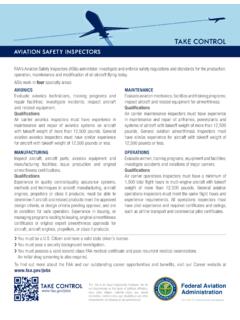Transcription of Advisory - Federal Aviation Administration
1 Advisory Departmentof Transportation Federal Aviation Circular Administration Subject: Safety Management Systems for Date: 1/8/15 AC No: 120-92B Aviation Service Providers Initiated by: AFS-900 Change: This Advisory circular (AC) provides information for Title 14 of the Code of Federal Regulations (14 CFR) part 121 air carriers that are required to implement Safety Management Systems (SMS) based on 14 CFR part 5. Specifically, this document provides a description of regulatory requirements, guidance, and methods of developing and implementing an SMS.
2 This AC may also be used by other Aviation service providers interested in voluntarily developing an SMS based on the requirements in part 5. An SMS is an organization-wide comprehensive and preventive approach to managing safety. An SMS includes a safety policy, formal methods for identifying hazards and mitigating risk, and promotion of a positive safety culture. An SMS also provides assurance of the overall safety performance of your organization. An SMS is intended to be designed and developed by your own people and should be integrated into your existing operations and business decisionmaking processes. The SMS will assist your organization s leadership, management teams, and employees in making effective and informed safety decisions.
3 Part 5 specifies a basic set of processes integral to an effective SMS but does not specify particular methods for implementing these processes. In other words, the regulation defines what must be accomplished, not how it must be accomplished. This AC provides additional guidance on how the SMS may be developed to achieve the safety performance objectives outlined by your organization. As is demonstrated by this AC, there is no one-size-fits-all method for complying with the requirements of part 5. This design is intentional, in that the Federal Aviation Administration (FAA) expects each air carrier to develop an SMS that works for its unique operation.
4 Thus, this AC provides guidance regarding designing and implementing acceptable methods of compliance with the requirements of part 5. These methods, however, are not the only means of compliance. /s/ John S. Duncan Director, Flight Standards Service 1/8/15 AC 120-92B CONTENTS Paragraph Page CHAPTER 1. INTRODUCTION 1-1. 1-2. Cancellation ..1 1-3. Applicability ..1 1-4. Scalability ..2 1-5. Contact CHAPTER 2. SAFETY MANAGEMENT SYSTEM (SMS) FOUNDATIONS 2-1. Safety Culture and Safety Management..3 2-2. SMS Fundamentals.
5 4 2-3. Conceptual Overview of SRM and 2-4. CHAPTER 3. SAFETY MANAGEMENT SYSTEM (SMS) COMPONENTS EXPLAINED 3-1. Overview of the Structure of Chapter 3-2. Subpart A: General ..10 3-3. Subpart B: Safety 3-4. Subpart C: Safety Risk 3-5. Subpart D: Safety Assurance ..28 3-6. Subpart E: Safety Promotion ..42 3-7. Subpart F: SMS Documentation and Recordkeeping ..44 CHAPTER 4: IMPLEMENTATION: BUILDING A SAFETY MANAGEMENT SYSTEM (SMS) 4-1. Process 4-2. Mapping and Analyzing Your 4-3. Conducting a Gap Analysis ..48 4-4. Preparing an Implementation 4-5. Phased SMS Implementation CHAPTER 5: INTEGRATING EXISTING SAFETY PROGRAMS INTO THE SAFETY MANAGEMENT SYSTEM (SMS) 5-1.
6 Purpose of this 5-2. Discussion of Individual Page iii 1/8/15 AC 120-92B Paragraph Page APPENDIX 1. SMS CROSS-REFERENCE FOR TRANSITIONING SMS PILOT PROJECT PARTICIPANTS (2 pages)..1 APPENDIX 2. SAFETY RISK MANAGEMENT (SRM) WORKSHEETS (8 pages) ..1 APPENDIX 3. SAMPLE SAFETY POLICY STATEMENT (2 pages) ..1 APPENDIX 4. IDENTIFYING THE ACCOUNTABLE EXECUTIVE (2 pages)..1 APPENDIX 5. SAMPLE GAP ANALYSIS AND IMPLEMENTATION PLAN EXCERPTS (2 pages) ..1 APPENDIX 6. REFERENCES AND ADDITIONAL INFORMATION (2 pages)..1 LIST OF FIGURES Figure 2-1.
7 Safety Management Decisionmaking Figure 3-1. Safety Risk Management Processes and Regulatory Figure 3-2. Sample Risk Matrix ..26 Figure 3-3. Safety Assurance Processes and Regulatory Requirements ..29 Figure 4-1. Recommended Safety Management System Implementation Figure 4-2. Safety Management System Development ..52 Page iv 1/8/15 AC 120-92B CHAPTER 1. INTRODUCTION 1-1. PURPOSE. a. General. This Advisory circular (AC) provides information to assist Title 14 of the Code of Federal Regulations (14 CFR) part 121 certificate holders in developing a Safety Management System (SMS).
8 It provides guidance material that aligns with the requirements, structure, and format of 14 CFR part 5, Safety Management Systems for Certificate Holders Operating under Part 121. It describes an acceptable means, but not the only means, to implement and maintain an SMS. Because complying with part 5 satisfies the SMS Standards of the international Civil Aviation Organization (ICAO), as published in ICAO Annex 19 for operations covered under Annex 6 Part I, the material in this AC is also consistent with those ICAO b. Integration. An SMS is not meant to be a separate system built alongside or on top of your other business systems.
9 An SMS should be integrated into your existing business structure. A properly integrated SMS fosters a fundamental and sustainable change in how you view and analyze data and information, how you make informed decisions, and how you develop new operational and business methods. SMSs are necessary to comply with part 5, but they are not substitutes for compliance with other Federal regulations. However, SMSs can assist service providers in meeting other regulatory requirements. c. Scalability. The SMS requirements of 14 CFR part 5 are applicable to a wide variety of types and sizes of operators. Therefore, those requirements are designed to be scalable, allowing operators to integrate safety management practices into their unique business models.
10 An SMS should be tailored to each specific operator; therefore, this AC cannot provide a single means of compliance that applies to all certificate holders who are required to develop and implement an SMS. 1-2. CANCELLATION. AC 120-92A, Safety Management Systems for Aviation Service Providers, dated August 12, 2010, is canceled. 1-3. APPLICABILITY. a. This AC Applies to Part 121 Certificate Holders. This AC applies to businesses that are considering applying for, have applied for, or hold a part 121 certificate. Part 5, requires a part 121 certificate holder to have an SMS that meets the requirements of part 5 and that is acceptable to the Administrator of the Federal Aviation Administration (FAA).










